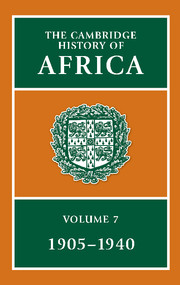Crossref Citations
This Book has been
cited by the following publications. This list is generated based on data provided by Crossref.
Killingray, David
and
Roberts, Andrew
1989.
An Outline History of Photography in Africa to ca. 1940.
History in Africa,
Vol. 16,
Issue. ,
p.
197.
Law, Robin
1989.
Slave-Raiders and Middlemen, Monopolists and Free-Traders: the supply of slaves for the Atlantic trade in Dahomeyc. 1715–1850.
The Journal of African History,
Vol. 30,
Issue. 1,
p.
45.
KILLINGRAY, DAVID
1991.
War and Society in Africa since 1800.
South African Historical Journal,
Vol. 25,
Issue. 1,
p.
131.
Maxon, Robert M.
1991.
The Devonshire Declaration: The Myth of Missionary Intervention.
History in Africa,
Vol. 18,
Issue. ,
p.
259.
Sidaway, James D.
and
Simon, David
1993.
Geopolitical transition and state formation: the changing political geographies of Angola, Mozambique and Namibia.
Journal of Southern African Studies,
Vol. 19,
Issue. 1,
p.
6.
Martin, Phyllis M.
1994.
Contesting Clothes in Colonial Brazzaville.
The Journal of African History,
Vol. 35,
Issue. 3,
p.
401.
Tomkins, Sandra M.
1994.
Colonial Administration in British Africa during the Influenza Epidemie of 1918–19.
Canadian Journal of African Studies / Revue canadienne des études africaines,
Vol. 28,
Issue. 1,
p.
60.
Callahan, Michael D.
1997.
The failure of ‘Closer Union’ in British East Africa, 1929–31.
The Journal of Imperial and Commonwealth History,
Vol. 25,
Issue. 2,
p.
267.
Leopold, Mark
2005.
‘WHY ARE WE CURSED?’: WRITING HISTORY AND MAKING PEACE IN NORTH WEST UGANDA.
Journal of the Royal Anthropological Institute,
Vol. 11,
Issue. 2,
p.
211.
Ndaywel è Nziem, Isidore
2006.
L’historiographie congolaise.
Civilisations,
p.
237.
BUELENS, FRANS
and
MARYSSE, STEFAAN
2009.
Returns on investments during the colonial era: the case of the Belgian Congo1.
The Economic History Review,
Vol. 62,
Issue. s1,
p.
135.
Leopold, Mark
2009.
Crossing the line: 100 years of the North-West Uganda/South Sudan border.
Journal of Eastern African Studies,
Vol. 3,
Issue. 3,
p.
464.
Killingray, David
2010.
A Companion to World War I.
p.
112.
RAZA, Saima
2012.
Italian Colonisation & Libyan Resistance to the Al-Sanusi of Cyrenaica (1911 – 1922).
Journal of Middle Eastern and Islamic Studies (in Asia),
Vol. 6,
Issue. 1,
p.
87.
Sumich, Jason
2018.
The Middle Class in Mozambique.
2019.
The Licit Life of Capitalism.
p.
172.
2019.
The Licit Life of Capitalism.
p.
279.
2019.
The Licit Life of Capitalism.
p.
37.
2019.
The Licit Life of Capitalism.
p.
285.
2019.
The Licit Life of Capitalism.
p.
247.





